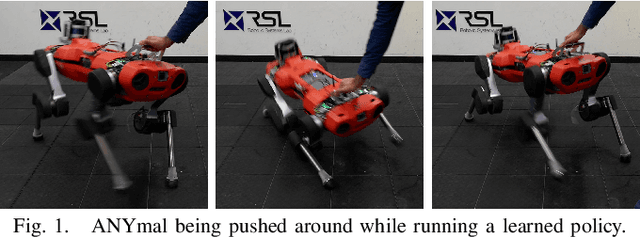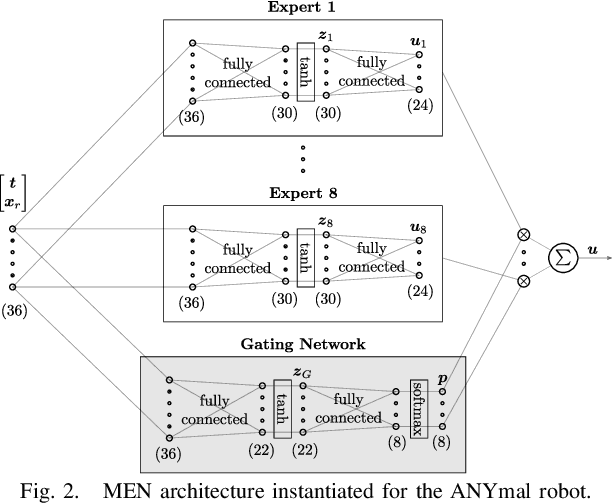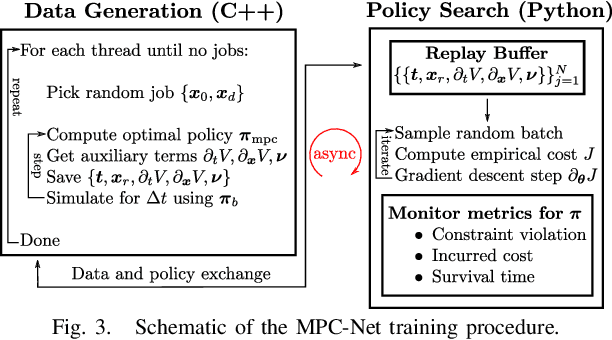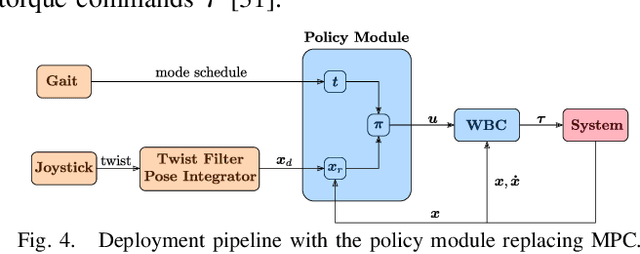Yuntao Ma
Learning to Open and Traverse Doors with a Legged Manipulator
Sep 07, 2024



Abstract:Using doors is a longstanding challenge in robotics and is of significant practical interest in giving robots greater access to human-centric spaces. The task is challenging due to the need for online adaptation to varying door properties and precise control in manipulating the door panel and navigating through the confined doorway. To address this, we propose a learning-based controller for a legged manipulator to open and traverse through doors. The controller is trained using a teacher-student approach in simulation to learn robust task behaviors as well as estimate crucial door properties during the interaction. Unlike previous works, our approach is a single control policy that can handle both push and pull doors through learned behaviour which infers the opening direction during deployment without prior knowledge. The policy was deployed on the ANYmal legged robot with an arm and achieved a success rate of 95.0% in repeated trials conducted in an experimental setting. Additional experiments validate the policy's effectiveness and robustness to various doors and disturbances. A video overview of the method and experiments can be found at youtu.be/tQDZXN_k5NU.
IN-Sight: Interactive Navigation through Sight
Aug 01, 2024



Abstract:Current visual navigation systems often treat the environment as static, lacking the ability to adaptively interact with obstacles. This limitation leads to navigation failure when encountering unavoidable obstructions. In response, we introduce IN-Sight, a novel approach to self-supervised path planning, enabling more effective navigation strategies through interaction with obstacles. Utilizing RGB-D observations, IN-Sight calculates traversability scores and incorporates them into a semantic map, facilitating long-range path planning in complex, maze-like environments. To precisely navigate around obstacles, IN-Sight employs a local planner, trained imperatively on a differentiable costmap using representation learning techniques. The entire framework undergoes end-to-end training within the state-of-the-art photorealistic Intel SPEAR Simulator. We validate the effectiveness of IN-Sight through extensive benchmarking in a variety of simulated scenarios and ablation studies. Moreover, we demonstrate the system's real-world applicability with zero-shot sim-to-real transfer, deploying our planner on the legged robot platform ANYmal, showcasing its practical potential for interactive navigation in real environments.
Learning Goal-Conditioned Representations for Language Reward Models
Jul 18, 2024



Abstract:Techniques that learn improved representations via offline data or self-supervised objectives have shown impressive results in traditional reinforcement learning (RL). Nevertheless, it is unclear how improved representation learning can benefit reinforcement learning from human feedback (RLHF) on language models (LMs). In this work, we propose training reward models (RMs) in a contrastive, $\textit{goal-conditioned}$ fashion by increasing the representation similarity of future states along sampled preferred trajectories and decreasing the similarity along randomly sampled dispreferred trajectories. This objective significantly improves RM performance by up to 0.09 AUROC across challenging benchmarks, such as MATH and GSM8k. These findings extend to general alignment as well -- on the Helpful-Harmless dataset, we observe $2.3\%$ increase in accuracy. Beyond improving reward model performance, we show this way of training RM representations enables improved $\textit{steerability}$ because it allows us to evaluate the likelihood of an action achieving a particular goal-state (e.g., whether a solution is correct or helpful). Leveraging this insight, we find that we can filter up to $55\%$ of generated tokens during majority voting by discarding trajectories likely to end up in an "incorrect" state, which leads to significant cost savings. We additionally find that these representations can perform fine-grained control by conditioning on desired future goal-states. For example, we show that steering a Llama 3 model towards helpful generations with our approach improves helpfulness by $9.6\%$ over a supervised-fine-tuning trained baseline. Similarly, steering the model towards complex generations improves complexity by $21.6\%$ over the baseline. Overall, we find that training RMs in this contrastive, goal-conditioned fashion significantly improves performance and enables model steerability.
USat: A Unified Self-Supervised Encoder for Multi-Sensor Satellite Imagery
Dec 02, 2023Abstract:Large, self-supervised vision models have led to substantial advancements for automatically interpreting natural images. Recent works have begun tailoring these methods to remote sensing data which has rich structure with multi-sensor, multi-spectral, and temporal information providing massive amounts of self-labeled data that can be used for self-supervised pre-training. In this work, we develop a new encoder architecture called USat that can input multi-spectral data from multiple sensors for self-supervised pre-training. USat is a vision transformer with modified patch projection layers and positional encodings to model spectral bands with varying spatial scales from multiple sensors. We integrate USat into a Masked Autoencoder (MAE) self-supervised pre-training procedure and find that a pre-trained USat outperforms state-of-the-art self-supervised MAE models trained on remote sensing data on multiple remote sensing benchmark datasets (up to 8%) and leads to improvements in low data regimes (up to 7%). Code and pre-trained weights are available at https://github.com/stanfordmlgroup/USat .
Learning Arm-Assisted Fall Damage Reduction and Recovery for Legged Mobile Manipulators
Mar 09, 2023Abstract:Adaptive falling and recovery skills greatly extend the applicability of robot deployments. In the case of legged mobile manipulators, the robot arm could adaptively stop the fall and assist the recovery. Prior works on falling and recovery strategies for legged mobile manipulators usually rely on assumptions such as inelastic collisions and falling in defined directions to enable real-time computation. This paper presents a learning-based approach to reducing fall damage and recovery. An asymmetric actor-critic training structure is used to train a time-invariant policy with time-varying reward functions. In simulated experiments, the policy recovers from 98.9\% of initial falling configurations. It reduces base contact impulse, peak joint internal forces, and base acceleration during the fall compared to the baseline methods. The trained control policy is deployed and extensively tested on the ALMA robot hardware. A video summarizing the proposed method and the hardware tests is available at https://youtu.be/avwg2HqGi8s.
Combining Learning-based Locomotion Policy with Model-based Manipulation for Legged Mobile Manipulators
Jan 11, 2022



Abstract:Deep reinforcement learning produces robust locomotion policies for legged robots over challenging terrains. To date, few studies have leveraged model-based methods to combine these locomotion skills with the precise control of manipulators. Here, we incorporate external dynamics plans into learning-based locomotion policies for mobile manipulation. We train the base policy by applying a random wrench sequence on the robot base in simulation and adding the noisified wrench sequence prediction to the policy observations. The policy then learns to counteract the partially-known future disturbance. The random wrench sequences are replaced with the wrench prediction generated with the dynamics plans from model predictive control to enable deployment. We show zero-shot adaptation for manipulators unseen during training. On the hardware, we demonstrate stable locomotion of legged robots with the prediction of the external wrench.
Imitation Learning from MPC for Quadrupedal Multi-Gait Control
Mar 26, 2021



Abstract:We present a learning algorithm for training a single policy that imitates multiple gaits of a walking robot. To achieve this, we use and extend MPC-Net, which is an Imitation Learning approach guided by Model Predictive Control (MPC). The strategy of MPC-Net differs from many other approaches since its objective is to minimize the control Hamiltonian, which derives from the principle of optimality. To represent the policies, we employ a mixture-of-experts network (MEN) and observe that the performance of a policy improves if each expert of a MEN specializes in controlling exactly one mode of a hybrid system, such as a walking robot. We introduce new loss functions for single- and multi-gait policies to achieve this kind of expert selection behavior. Moreover, we benchmark our algorithm against Behavioral Cloning and the original MPC implementation on various rough terrain scenarios. We validate our approach on hardware and show that a single learned policy can replace its teacher to control multiple gaits.
 Add to Chrome
Add to Chrome Add to Firefox
Add to Firefox Add to Edge
Add to Edge